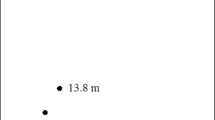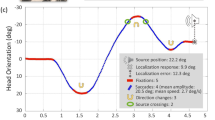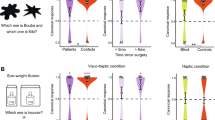Abstract
Do blind persons develop capacities of their remaining senses that exceed those of sighted individuals? Besides anecdotal suggestions, two views based on experimental studies have been advanced1. The first proposes that blind individuals should be severely impaired, given that vision is essential to develop spatial concepts2. The second suggests that compensation occurs through the remaining senses, allowing them to develop an accurate concept of space3. Here we investigate how an ecologically critical function, namely three-dimensional spatial mapping, is carried out by early-blind individuals with or without residual vision. Subjects were tested under monaural and binaural listening conditions. We find that early-blind subjects can map the auditory environment with equal or better accuracy than sighted subjects. Furthermore, unlike sighted subjects, they can correctly localize sounds monaurally. Surprisingly, blind individuals with residual peripheral vision localized sounds less precisely than sighted or totally blind subjects, confirming that compensation varies according to the aetiology and extent of blindness4. Our results resolve a long-standing controversy in that they provide behavioural evidence that totally blind individuals have better auditory ability than sighted subjects, enabling them to compensate for their loss of vision.
This is a preview of subscription content, access via your institution
Access options
Subscribe to this journal
Receive 51 print issues and online access
$199.00 per year
only $3.90 per issue
Buy this article
- Purchase on Springer Link
- Instant access to full article PDF
Prices may be subject to local taxes which are calculated during checkout



Similar content being viewed by others
References
Rauschecker, J. P. Compensatory plasticity and sensory substitution in the cerebral cortex. Trends Neurosci. 18, 36–43 (1995).
Axelrod, S. Effects of Early Blindness (Am. Found. Blind, New York, 1959).
Rice, C. E. Early blindness, early experience and perceptual enhancement. Res. Bull. Am. Found. Blind 22, 1–22 (1970).
Kujala, T.et al. Electrophysiological evidence for cross-modal plasticity in humans with early- and late-onset blindness. Psychophysiology 34, 213–216 (1997).
Feldman, D. E. & Knudsen, E. I. An anatomical basis of visual calibration of the auditory space map in the barn owl's midbrain. J. Neursci. 17, 6820–6837 (1997).
Chalupa, L. M. & Rhoades, R. W. Responses of visual, somatosensory, and auditory neurones in the golden hamster's superior colliculus. J. Physiol. 270, 595–626 (1977).
King, A. J. Amap of auditory space in the mammalian brain: neural computation and development. Exp. Physiol. 78, 559–590 (1993).
Middlebrooks, J. C. & Knudsen, E. I. Aneural code for auditory space in the cat's superior colliculus. J.Neurosci. 4, 2621–2634 (1984).
Spitzer, M. W. & Semple, M. N. Interaural phase coding in auditory midbrain: influence of dynamic stimulus features. Science 254, 721–723 (1991).
Stumpf, E., Toronchuk, J. M. & Cynader, M. S. Neurons in cat primary auditory cortex sensitive to correlates of auditory motion in three dimensional space. Exp. Brain Res. 88, 158–168 (1992).
Toronchuk, J. M., Stumpf, E. & Cynader, M. S. Auditory cortex neurons sensitive to correlates of auditory motion—underlying mechanisms. Exp. Brain Res. 88, 169–180 (1992).
Rauschecker, J. P. & Harris, L. R. Auditory compensation of the effects of visual deprivation in the cat's superior colliculus. Exp. Brain Res. 50, 69–83 (1983).
Rauschecker, J. P. & Korte, M. J. Auditory compensation for early blindness in cat cerebral cortex. J.Neurosci. 13, 4538–4548 (1993).
Rauschecker, J. P. & Kniepert, U. Auditory localization behaviour in visually deprived cats. Eur. J. Neurosci. 6, 149–160 (1994).
Kujala, T., Alho, K., Paavilainen, P., Summala, H. & Näätänen, R. Neural plasticity in processing of sound localization by the early blind: an event-related potential study. Electroencephalogr. Clin. Neurophysiol. 84, 469–472 (1992).
Kujala, T.et al. Auditory an somatosensory event-related potentials in early blind humans. Exp. Brain Res. 104, 519–526 (1995).
Jacobs, K. M. & Donoghue, J. P. Reshaping the cortical motor map by unmasking latent intracortical connections. Science 251, 944–947 (1991).
Butler, R. A. An analysis of the monaural displacement of sound in space. Percept. Psychophys. 41, 1–7 (1987).
Slattery, W. H. & Middlebrooks, J. C. Monaural sound localization: acute versus chronic unilateral impairement. Hearing Res. 75, 38–46 (1994).
Poirier, P., Miljours, S., Lassonde, M. & Lepore, F. Sound localization in acallosal human listeners. Brain 116, 53–69 (1993).
Acknowledgements
We thank the Regroupement pour les Aveugles et Amblyopes de Montréal (RAAM), especially S. Poulin and F. Boulet, for their assistance in recruiting participants. This work was supported by grants from NSERC and FCAR.
Author information
Authors and Affiliations
Corresponding author
Rights and permissions
About this article
Cite this article
Lessard, N., Paré, M., Lepore, F. et al. Early-blind human subjects localize sound sources better than sighted subjects. Nature 395, 278–280 (1998). https://doi.org/10.1038/26228
Received:
Accepted:
Issue Date:
DOI: https://doi.org/10.1038/26228
This article is cited by
-
Flexible cue anchoring strategies enable stable head direction coding in both sighted and blind animals
Nature Communications (2022)
-
Partial visual loss disrupts the relationship between judged room size and sound source distance
Experimental Brain Research (2022)
-
Morphometric evaluation of cerebellar structures in late monocular blindness
International Ophthalmology (2021)
-
No effect of 10-week training in click-based echolocation on auditory localization in people who are blind
Experimental Brain Research (2021)
-
The accuracy of auditory spatial judgments in the visually impaired is dependent on sound source distance
Scientific Reports (2020)
Comments
By submitting a comment you agree to abide by our Terms and Community Guidelines. If you find something abusive or that does not comply with our terms or guidelines please flag it as inappropriate.



